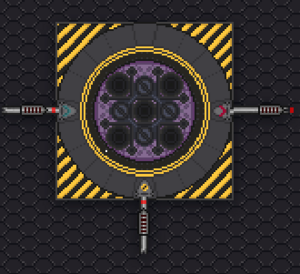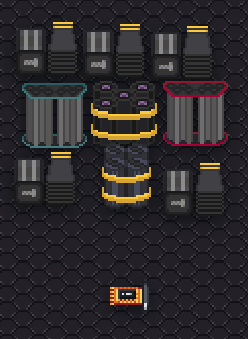Guide to the Nuclear Reactor: Difference between revisions
XeonMations (talk | contribs) m (→Tips) |
XeonMations (talk | contribs) mNo edit summary |
||
| (3 intermediate revisions by the same user not shown) | |||
| Line 1: | Line 1: | ||
{{Under construction|reason=This engine is currently | {{Under construction|reason=This engine is currently in PR hell, please try again later, or yell at our maintainers!}}So, your [[Supermatter Engine|main source of power]] exploded. What now? | ||
Well, not to worry, for Nanotrasen's subcompany: Hayne's Power Solutions™ have your back! By ordering our <s>newly</s> created fission based nuclear reactor, we guarantee full power availability to your station, today! | Well, not to worry, for Nanotrasen's subcompany: Hayne's Power Solutions™ have your back! By ordering our <s>newly</s> created fission based nuclear reactor, we guarantee full power availability to your station, today! | ||
| Line 14: | Line 14: | ||
The Nuclear Reactor has two inputs: Moderator and Coolant. | The Nuclear Reactor has two inputs: Moderator and Coolant. | ||
The first thing we're going to worry about is the coolant loop. Our reactor is cooled through a simple process: Uranium fuel rods are placed into the reactor which immediately starts the reaction, creating constant heat. Our coolant gas is pumped into the reactor, heats up to the heat of the reactor, and then carries said heat out, alongside some tritium if the engine has a fuel in its moderator line. The colder the gas you put into the loop, the faster the reactor cools down. Innately, it’s set up so that the temperature loss from coolant intake is balanced out against the heat generated by the fuel rods, represented by the controllable figure called K (Neutrons per generation). | The first thing we're going to worry about is the coolant loop. Our reactor is cooled through a simple process: Uranium fuel rods are placed into the reactor which immediately starts the reaction, creating constant heat. Our coolant gas is pumped into the reactor, heats up to the heat of the reactor, and then carries said heat out, alongside some tritium if the engine has a fuel in its moderator line. The colder the gas you put into the loop, the faster the reactor cools down. Innately, it’s set up so that the temperature loss from coolant intake is balanced out against the heat generated by the fuel rods, represented by the controllable figure called K (Neutrons per generation). | ||
'''NOTE''' that the coolant gas can potentially retain heat and actually heat up the reactor, so, be certain to check the thermometers on the coolant loop often! | |||
Also, do not forget to have a limit to the amount of coolant you input into the reactor, as adding too much can overpressurize it, and adding too little can cause it to meltdown! | |||
Second is the moderator. For our reactor to create power, it has to consume a fuel gas inside it's moderator input. The normal moderator we use by default for standard nuclear reactors is a 90% oxygen and 10% plasma mix. The moderator input can also be used to affect how our reactor works, such as making the control rods more effective, or the amount of heat that is transferred from the reactor to the coolant gas line. Remember that the reactor will consume any moderator gas you use in the moderator line! | The recommended amount of coolant in the reactor at any point in time is roughly 1000-1500kpa. | ||
Second is the moderator. For our reactor to create power, it has to consume a fuel gas inside it's moderator input. The normal moderator we use by default for standard nuclear reactors is a 90% oxygen and 10% plasma mix at ~1500kpa. The moderator input can also be used to affect how our reactor works, such as making the control rods more effective, or the amount of heat that is transferred from the reactor to the coolant gas line. Remember that the reactor will consume any moderator gas you use in the moderator line! | |||
Don't forget to add a power line from the nuclear reactor's core, in order to be able to harvest its precious fission based energy! | Don't forget to add a power line from the nuclear reactor's core, in order to be able to harvest its precious fission based energy! | ||
{{Important|Title=Important reminder!|Note=The reactor | {{Important|Title=Important reminder!|Note=The reactor will only produce 150kw of power, if it has no fuel moderator gas!|Image=Wire_1_1.PNG|Color=#FFC}} | ||
== Reactor Setup 101 == | == Reactor Setup 101 == | ||
Revision as of 18:55, 22 November 2024
So, your main source of power exploded. What now?
Well, not to worry, for Nanotrasen's subcompany: Hayne's Power Solutions™ have your back! By ordering our newly created fission based nuclear reactor, we guarantee full power availability to your station, today!
Terminology
Before we begin, it's important you understand a few key words that are going to be repeated throughout this guide:
- Neutrons per generation (K): Rate of heat gain in the reactor.
- Moderator: Gasses that influence the performance and power production of the reactor
- Power: The ratio between the current heat and the heat required for a meltdown
How the Reactor Works
The Nuclear Reactor has two inputs: Moderator and Coolant.
The first thing we're going to worry about is the coolant loop. Our reactor is cooled through a simple process: Uranium fuel rods are placed into the reactor which immediately starts the reaction, creating constant heat. Our coolant gas is pumped into the reactor, heats up to the heat of the reactor, and then carries said heat out, alongside some tritium if the engine has a fuel in its moderator line. The colder the gas you put into the loop, the faster the reactor cools down. Innately, it’s set up so that the temperature loss from coolant intake is balanced out against the heat generated by the fuel rods, represented by the controllable figure called K (Neutrons per generation).
NOTE that the coolant gas can potentially retain heat and actually heat up the reactor, so, be certain to check the thermometers on the coolant loop often!
Also, do not forget to have a limit to the amount of coolant you input into the reactor, as adding too much can overpressurize it, and adding too little can cause it to meltdown!
The recommended amount of coolant in the reactor at any point in time is roughly 1000-1500kpa.
Second is the moderator. For our reactor to create power, it has to consume a fuel gas inside it's moderator input. The normal moderator we use by default for standard nuclear reactors is a 90% oxygen and 10% plasma mix at ~1500kpa. The moderator input can also be used to affect how our reactor works, such as making the control rods more effective, or the amount of heat that is transferred from the reactor to the coolant gas line. Remember that the reactor will consume any moderator gas you use in the moderator line!
Don't forget to add a power line from the nuclear reactor's core, in order to be able to harvest its precious fission based energy!

|
Important reminder!
The reactor will only produce 150kw of power, if it has no fuel moderator gas! |
Reactor Setup 101
After ordering your nuclear reactor from cargo, don't forget to order a crate of RBMK grade nuclear fuel rods as well!
The first step is to take a moment to look at each part in the crate:
|
|
|
|
|
Each crate comes with 5 walls, 1 input, 1 output, 1 moderator input, 1 core and 1 control rod computer board. With these parts, you should be able to assemble your own reactor with our patented modular reactor design!
Here is an example design:
After assembly, you are able to use a multitool to confirm your reactor design by updating the core. Here is the above design after it's parts and design have been confirmed:

Once you have your reactor built, make sure to give it a proper coolant and moderator supply, and to handle the waste gases from it. After you have confirmed that, you are able to link a control rod computer to the reactor with a multitool.
After all that, you may now insert the fuel rods and adjust the control rod insertion via the control rod computer. Don't forget you can monitor the reactor's statistics with your PDA!
Gases
Fuel
|
|
|
Permeability
|
|
Depletion
|
Fuel rods
|
|
|
Maintenance
So you’ve started the reactor up, but your job isn’t done yet. ever. You’ve still got to prepare to shut the reactor down, change the rods, and make sure it doesn’t blow up halfway! The higher the K the more power and heat you produce, at 1k it should be stable, but if it’s not, adjust the decimal points.
Shutting down the reactor
Once your timer to change the rods is up, go ahead and turn the reactor rod control to 0 K, this will cause the reactions in the reactor to stop, and slowly settle down, while this is happening, you want to insert two co2 cans into the direct moderator input, and set the moderator to 1000-1500 kpa, this will ration out your 9000kpa odd co2 for shutdown. Once the reactor power is under 20 percent, you are then able to remove the fuel rods. This will shut the reactor down for good, now you want to unwrench your co2 cans, refill them and bring them back again. You are now good to insert new rods into the reactor and start it up again. NOTE: Please keep spent rods away from normal rods, remember to reset the moderator input amount.
Repairing the reactor
If your reactor gets damaged, either from the pressure or heat, you can repair it with a welding tool and sealant, this will repair the seals and make sure you don’t blow up next time you start it up.
Tips
- Be careful to not exhaust your plasma supply. It is recommended you don't max out the moderator input when youre running plasma + O2, or you're at a tangible risk of running out of those gasses from atmos.
- The reactor consumes moderator gasses very quickly, so keep this in mind before you use permeability gasses for riskier setups.
- You don’t need to shut down the reactor to do maintenance, you only need to bring it down to 20% power.
- This engine synergises well with other atmos based engines, try hooking it up to a TEG for free power.
- You can cook food such as steak on the reactor's surface.
- If the reactor makes banging noises, it’s not being actively cooled with coolant, and is taking damage.
- Don't forget you can see the health of the nuclear reactor by looking at how its seals are looking!
Sabotage
Sabotaging the Nuclear Reactor is incredibly easy to do, but can also be incredibly easy to fix depending on how much effort you put into your handiwork. Make sure there are no competent engineers nearby, roll up your sleeves, and let's get to work. You have a choice of starting either a meltdown or a blowout, with the latter being the deadliest but easiest to fix.
Meltdown:
- Flood reactor moderator line with plasma, they won't be able to mitigate the reaction with control rods.
- Shut off coolant entirely. Raise control rods.
- Swap all fuel out with spent fuel, as it's way stronger.
Blowout:
- Shut off exit valve for quick overpressure.
- Cause a pipefire in the coolant line (LETHAL).
- Tack heater onto coolant line (can also cause straight meltdown)
















